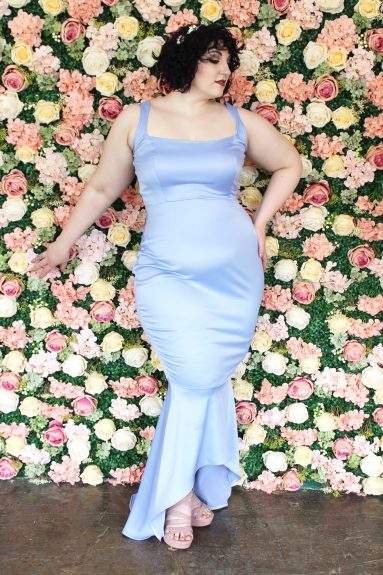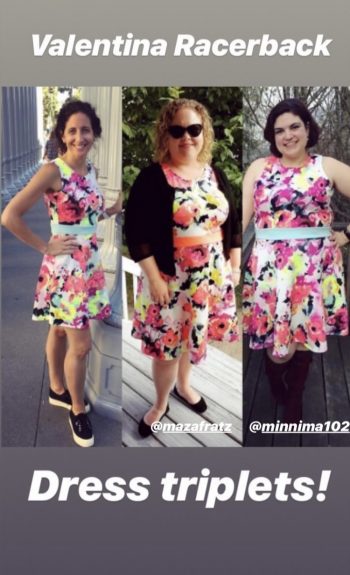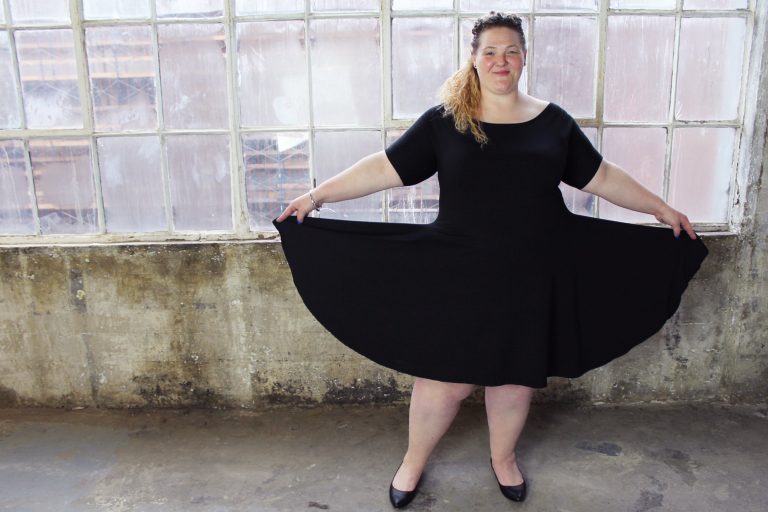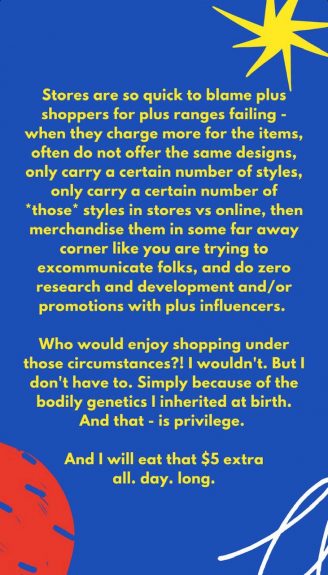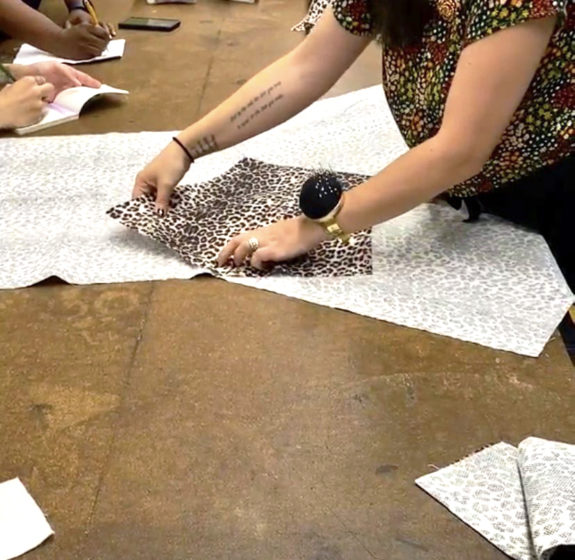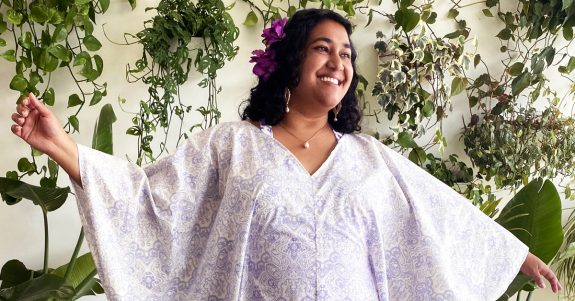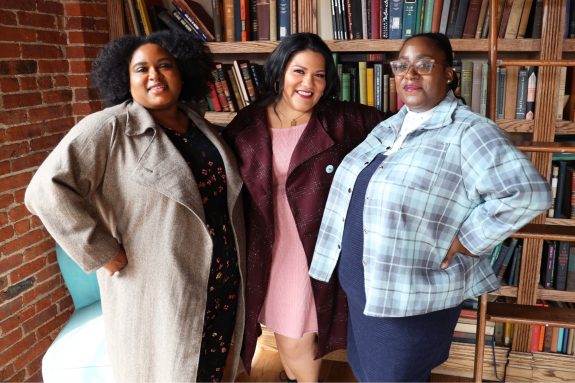By Katie Sotack
I was a fat child. I say that with all the love and tenderness in my heart.
Equally so, anyone who has seen me in real life or via Instagram can attest to my love for femme fashion. An easy way to identify me in college was to search for bright, bubblegum pink across the 250 acre campus. I would not go out unless I had a fun skirt and powerful pair of six inch heels to match. I was the equivalent of Carrie Bradshaw; a self involved blogger who’d spend her last cent on designer clothes.
However, I didn’t fit in designer. Even at my smallest- a glorified medium in some stores and an XL in others, Bloomingdales wouldn’t spare me a glance. And I can recall with absolute horror, the nightmare that was shopping for my prom dress.
An absolute dream for anyone who secretly desires to be a princess (which I do) and yet on the smallest end of plus size, I couldn’t fit into a single dress at any retail store. I cried for days and solemnly attested that I just wouldn’t attend prom. Luckily for me, I have a fabulous mother who whisked me away to get a dress specially made from a small local shop, even if it ended up costing four times as much as all my straight sized friends’ dresses.
A lot of things have changed since my senior prom in 2015. We’ve had three different presidents in that time, TikTok has taken the world by storm, and we’ve been (kinda) stuck insides for the past two years due to a life altering global pandemic. Unfortunately for the 72% of shoppers that are plus size, the fashion industry hasn’t moved past it’s archaic sizing standards and ridiculously jacked up prices.
As a fat fashionista, I thought it time to explore this.
This is about attitudes, about who is valued. This is about the industry deciding who the fashion customer is. You can’t design for someone you don’t value.
Stephanie Thomas of @cur8able
Personally, as a plus size shopper, it can feel like the industry hates us and purposefully goes out of their way to be exclusive. When you’ve wandered a store and found everything’s too tiny to fit you it’s dehumanizing. In a SmartGlamour blog, I wrote about embracing your body and how properly fitting clothes can enhance your self-esteem.
However, after you’ve spent the day trying on clothes so small, your body is bursting at the seams like a sausage on high heat when the casing is too tight, metaphorically ditching the prom seems like the safest option. Even the most zealous body positive warriors can’t magically make something fit them when plus size options (specifically anything above a 3X) are just not available.
Who would’ve thought that $328 billion industry was so destitute they couldn’t afford an extra inch of fabric on either side?
So as not to lose my sanity, I view this fatphobia as a generational trauma of sorts. There’s no switch built on the backside of fashion designers that makes them hate fat people. For many, I doubt it’s even in the forefront of their minds. And when being body positive sits high on the brain, the thought is crushed, by professors and the model of the industry.
In a recent TikTok posted by SmartGlamour creator, Mallorie Dunn, she addressed her time at the Fashion Institute of Technology, or FIT. During Dunn’s first year at the prestigious college she drew relatively slim croquis- a quick sketch of a live model. However, her professors informed her that said models were still too curvy. A proper croqui is six foot nine! The average American woman isn’t nearly as elongated at five foot three. Never mind the fact that the average American woman is a size 16/18 according to Racked. It’s a massive failure on the retailers’ part to limit their sizing to XS-XL; sometimes with even less options.
via SmartGlamour TikTok
Stephanie Thomas of Cur8able.com hit the nail on the head, “This is about attitudes, about who is valued. This is about the industry deciding who the fashion customer is. You can’t design for someone you don’t value.” Thomas works with fashion brands to introduce technology that creates “Accessible, Smart, Fashionable clothing for people with disabilities”. The work is personal for her, given that she herself is a disabled stylist. While the original context behind the quote deals with a specific subset of fashion neglect, it can be extended to any fashion consumer that doesn’t fit the narrow archetype destined to wear most brands.
With plus size customers making up only 12% of the total revenue from apparel, but almost three quarters of the American public, it is clear the fashion industry is more concerned with exclusivity than making money.
This is a strange standard that we don’t talk about enough. Most businesses function based on the bottom line, yet in the case of the fashion industry they are actively harming their means to perpetuate the image of a thin, white, able pseudo-holy character. It’s about one standard of conventional attractiveness and how their clothes will get you there (so long as you already mostly fit the mold).
Take the following TikTok for example. Dunn illustrates the difference between a 1X and a 5X being an inch or two difference on both sides of the garment.
The difference between a SmartGlamour 1X and 5X
Some still might say, every inch adds up. So let’s break down the pricing via the way SmartGlamour does it. All products are handmade, a time consuming expense, and according to Mallorie, only marked up half what the brands who require a retail middle man need. Cotton Jersey fabric ranges from $6.50-6.80 per yard – our go-to retailer charges us $5. To make our Shonda Swing Dress in a 1X, the material cost equates to roughly $12.50.
SG puts a premium on ethical pricing, equating to a 250% mark up for overhead and profit- only half the regular industry percentage. Dunn bases the price off the 1X-2X sizing that is the majority of her customers and the American femme population. For a dress like the Shonda Swing that requires plenty of fabric, the profit margin between a 1X and an XXS has a difference of $2.50 overall. There is also a $2.50 difference between a 1X and a 15X. This may seem to cut into the bottom line, however with a retail price of $65, the brand would still make $39.00 off a 15X customer, as opposed to the $41.50 of a 1X consumer and the $46.50 off an XXS buyer.
It’s hardly a difference that would break the bank. Especially when you consider that XXS and 15X customers are roughly equal outliers in the majority of purchases. When you remove the cost saved from an XXS buyer and contribute it to a 15X purchaser, SmartGlamour sacrifices $1.50 to give plus size buyers the basic decency of fair pricing.
All people deserve equal access to clothing.
Because it’s not just the plus size community that suffers. It’s any clothing consumer that doesn’t fit a brand’s narrow idea of what perfect looks like. There are many small details that make clothing inaccessible to disabled communities, people of color, the elderly, etc.
If you’ve never had to experience the subhuman soul crushing despair of the world not being made for you, I implore you to consider what it would be like to not get dressed in the morning. For things to fit like you wore it in second grade or your fingers being too numb to work the buttons on a dress shirt. Imagine missing your prom because no dress would fit your body or work with your wheelchair.
Pictured it?
Good.
Now ask yourself why clothing should narrow a person’s world like that? Doesn’t it seem financially, socially, and ethically more appealing to make clothes that fit all of us?
It’s time to change the brands we support and the way designers are taught.
It’s time to live a life dedicated to fitting our minds and bodies rather than an ideal.
If you ever didn’t fit into a prom dress, it’s time to accept that and be so eternally grateful that the industry is changing. Even if it’s only one small, local brand at a time.
That is why Smartlamour was created. In the brand’s About Page, Dunn addressed the reason she feels compelled to create clothing for customers of all backgrounds. “I don’t just want you to buy my clothes. I want you to buy the clothes that you want – that you need – that you go into your closet to look for but don’t exist. I want you to create the pieces you need for your life, style, and body that will empower you to feel more confident and use that feeling to take steps in the journey to love your body.”
When brands start treating everyone’s bodies like they’re worthy, it’s empowering and freeing. Dunn has built a home of happy customers that return again and again because not only their needs but their wants are being met. It’s become bigger than clothing and blossomed into a community where marginalized people can share their once private and embarrassing struggles and be met with solutions, acceptance, and support.


